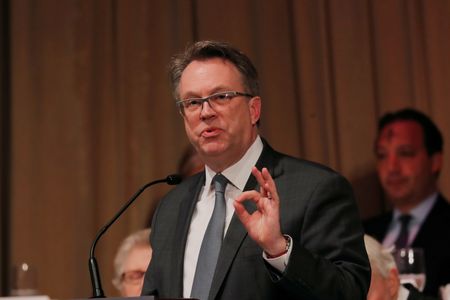By Michael S. Derby
(Reuters) -Federal Reserve Bank of New York President John Williams welcomed the relative stability of longer-term inflation expectations on Wednesday while signaling some puzzlement over data showing a notable number of Americans expect an outright decline in price pressures at some point.
“The importance of maintaining well-anchored inflation expectations is a bedrock principle of modern central banking, but its precise meaning and validation has been open to interpretation,” Williams told an audience in Zurich. “The news is mostly good — longer-run inflation expectations in the United States have remained remarkably stable at levels broadly consistent with the [Federal Open Market Committee’s] longer-run goal.”
Williams did not comment on monetary policy or the economic outlook in his appearance. The New York Fed Bank president, who is also vice chairman of the rate-setting FOMC, tackled the outlook for price pressures as the Fed has been pressing forward aggressively with interest rate hikes aimed at lowering the highest levels of inflation seen in four decades.
But so far, hikes in the Fed’s target rate range, now standing between 3.75% and 4%, have not lowered price pressures back toward the 2% official target in any notable way.
Following last week’s FOMC meeting, some Fed officials have made comments that opened the door to slower rate rises over coming meetings, while also signaling that the final stopping point for the tightening campaign could be higher than the 4.6% policy makers penciled in at their September meeting.
The government is set to release data on consumer price levels on Thursday. Economists surveyed by Reuters expect the consumer price index to have risen by 8% in October from the same month in 2021. The Fed’s preferred inflation measure, the personal consumption expenditures price index, was up by 6.2% in September from the same month a year ago.
Fed officials have long contended that public expectations of price pressures in the future exert a strong influence on where inflation is today, and many private sector economists agree. Officials have also repeatedly pointed to the relative stability of longer-term inflation expectations, which can be measured in multiple ways, as a vote of confidence by the public that the Fed will get inflation back to target at some point.
UNCERTAINTY UP AMID RISING DEFLATION FEARS
Uncertainty over the inflation outlook has risen, Williams said, adding that based on recent data, “The one surprising wrinkle worth further study is the increasing divergence in views about future inflation, including the high share of those expecting deflation, and what this portends for the future.”
Analysts at BMO Capital Markets said Williams’ sanguine views on inflation expectations could signal an evolution in his outlook, calling it “notable” to see an FOMC vice chair talking about rising deflation expectations.
Deflation is an outright decline in price pressures, and it’s somewhat surprising that some would worry about such an outlook at a time of high inflation and few clear signs of imminent relief.
A paper from the New York Fed released last month said that public expectations of deflation have been on the upswing this year. The paper’s authors saw this unexpected development in a positive light and said those with this view “are more likely to be optimistic about the outlook for the economy.”
There has been mounting evidence, including declining supply chain disruptions and falling used car prices, that high levels of inflation will cool over time.
“My personal hypothesis is that we’re on the back end…not on the front end” of the inflation surge, Richmond Fed president Thomas Barkin said Wednesday. “Commodity prices seem to be cooling, supply chains seem to be easing up, excess spending is being spent down, and the Fed is raising rates and doing what we need to do about it.”
(Reporting by Michael S. Derby; Editing by Leslie Adler)

